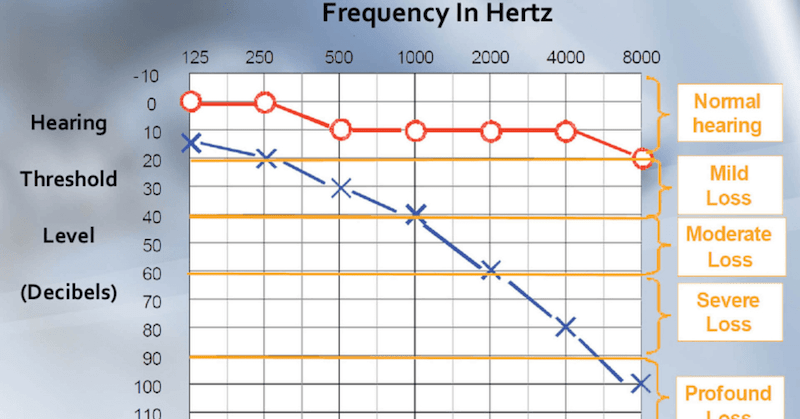What is an Audiogram?

An audiogram is a graph that shows the threshold of sound in decibels and hertz. It can be used to diagnose hearing loss. The Y axis represents the intensity, in decibels, and the X axis, the frequency. Depending on the type of hearing problem, the patient may receive an audiogram if certain conditions are present.
Normal hearing range
An audiogram is a picture of your hearing ability. It shows you what loud sounds are difficult to hear and what volume sounds are normal. It's an easy way to see the extent of your hearing loss. Audiograms also show you how different pitches affect your hearing, and what level you're hearing is within your hearing range.
Normal hearing is the range between -10 and 15 decibels for each threshold. Hearing within this range is considered normal for most adults. Hearing thresholds higher than this indicate hearing loss.
Types of hearing loss
Audiograms can be used to diagnose a range of different hearing problems. They measure the ability to detect different sounds, using threshold levels of loudness and frequency. When the threshold levels are steady, a person is considered to have normal hearing. However, if a person has a drop or rise in the line, it indicates that he or she is suffering from a hearing loss at certain frequencies. In cases of aging-related hearing loss, a line that slopes down for higher frequencies is indicative of severe hearing loss.
There are many different types of hearing loss, including conductive and sensorineural. The former is more likely to require surgical treatment, while the latter is more likely to be corrected naturally. Conduction hearing loss occurs when there is a problem with sound transmission through the entire outer ear mechanism, including the tympanic membrane, ossicles, and bones. In bone conduction hearing loss, the sound is transmitted through the skull to the inner ear via the ear bones.
Tests used to determine hearing loss
There are several types of tests used to determine the cause of hearing loss. One of these is the tuning fork test. This involves striking a metal tuning fork on the bone behind the ear. The frequency and length of time that the tuning fork stays on the bone will tell the audiologist if the patient is losing hearing. Other tests include bone conduction testing and air conduction testing.
These tests are done to determine if a patient has conductive or sensorineural hearing loss. Sensorineural hearing loss occurs when there is a problem with the nerve cells in the inner ear that control hearing. The condition is usually permanent and affects the patient's ability to hear most or all sounds. Treatment varies depending on the severity of the hearing loss.
Filling out an audiogram
Audiograms are the result of a hearing test. The information they provide can be confusing, but knowing a little bit about them can help you make sense of them. You can use an audiogram to guide your clinical practice in managing hearing loss. Read on to learn about the basic principles of audiometry and how to read and interpret an audiogram.
An audiogram plots hearing thresholds on a horizontal axis. The lowest level is 250 Hertz, and the highest is 8000 Hz. As you move from left to right, the sounds you hear become higher-pitched. Most speech is within this range. Higher-pitched sounds are more difficult to detect.
